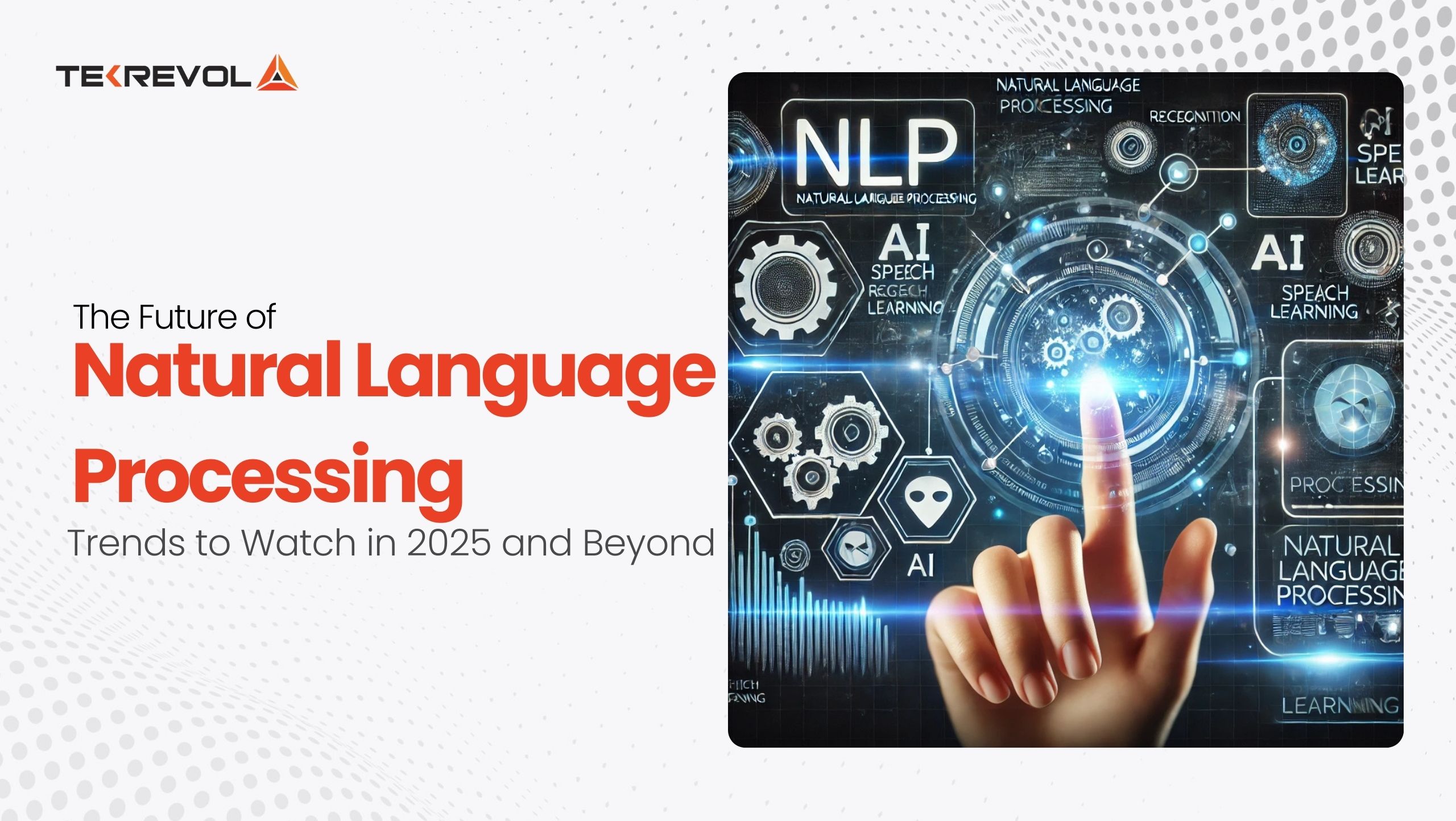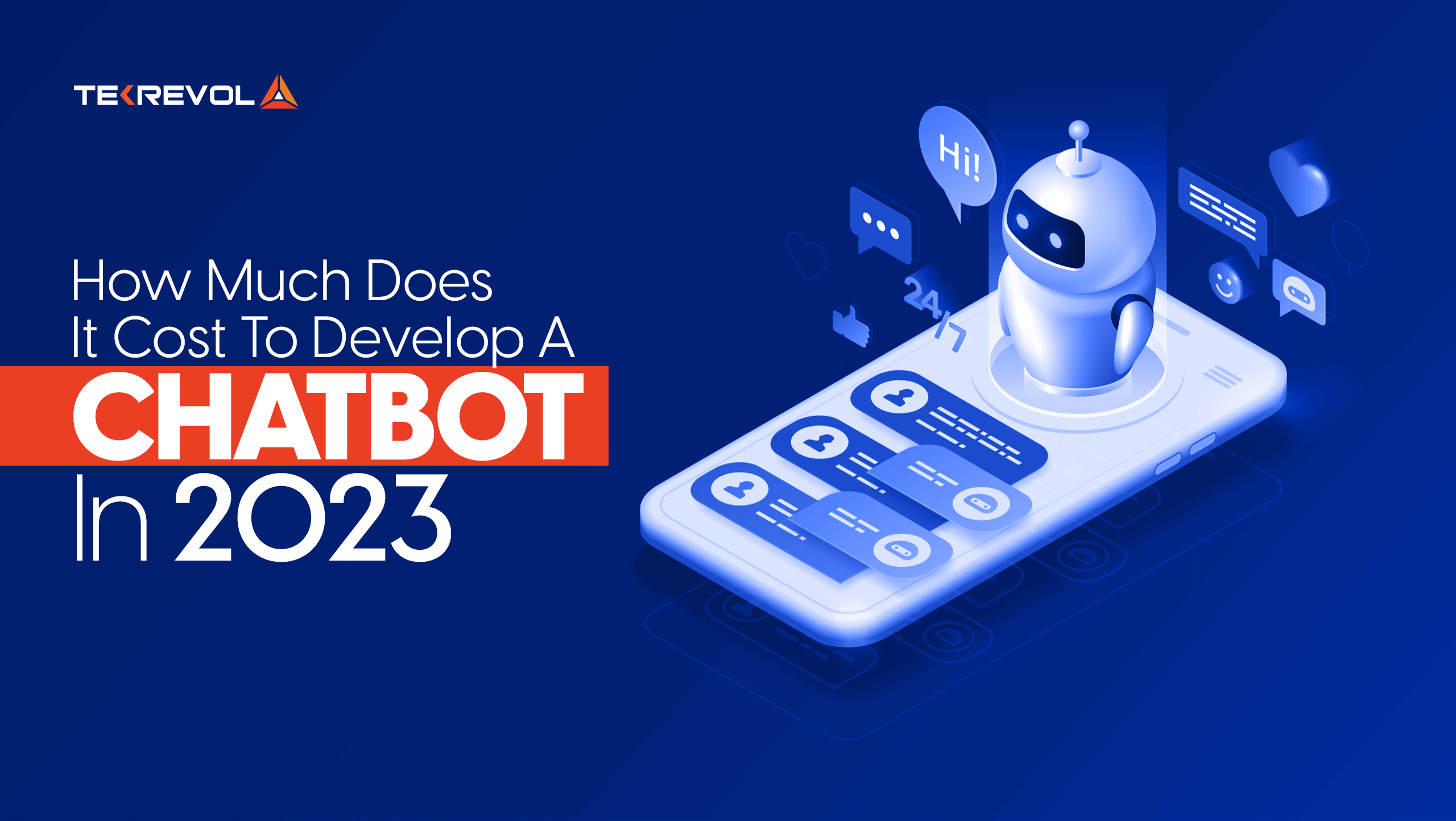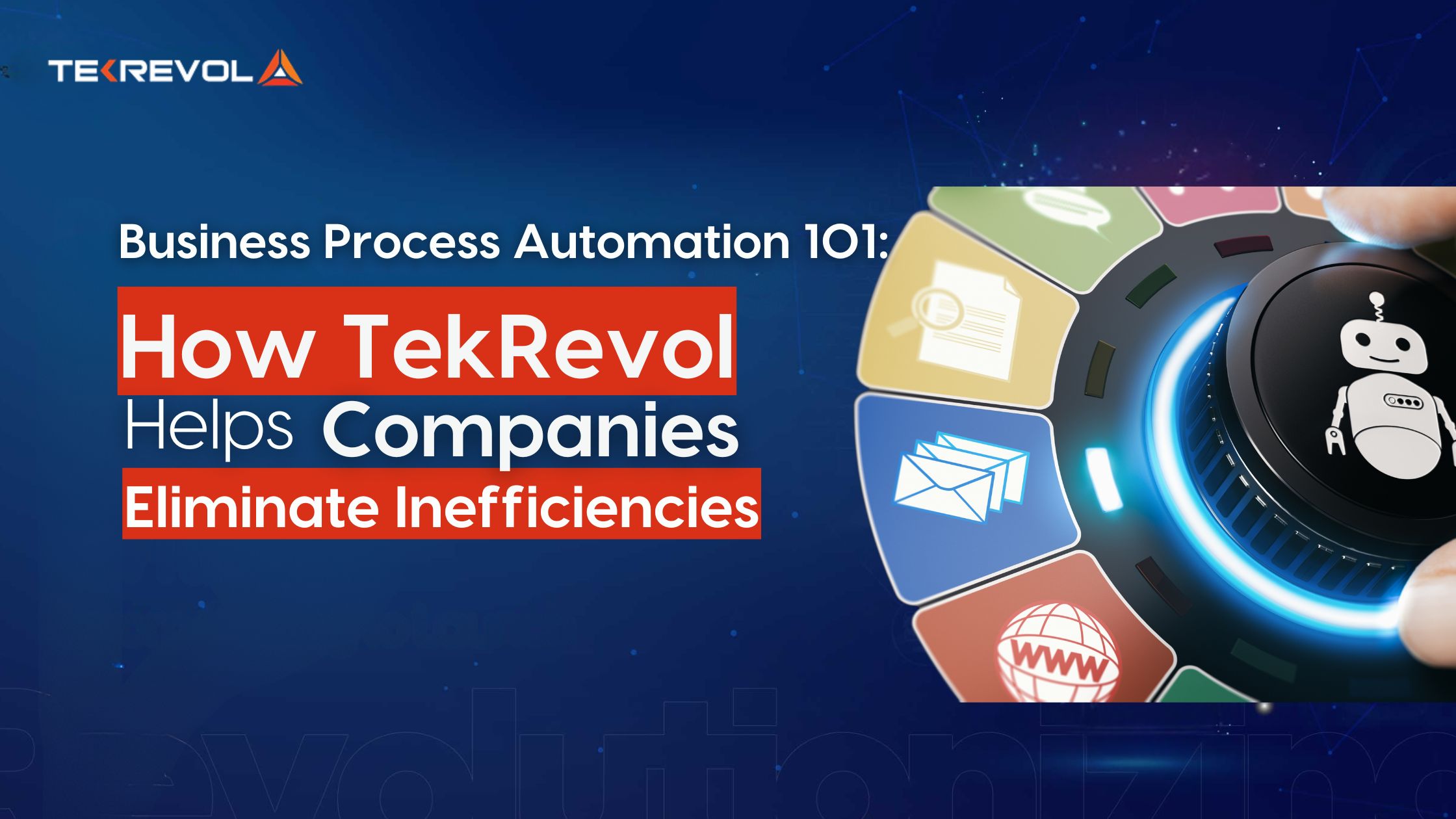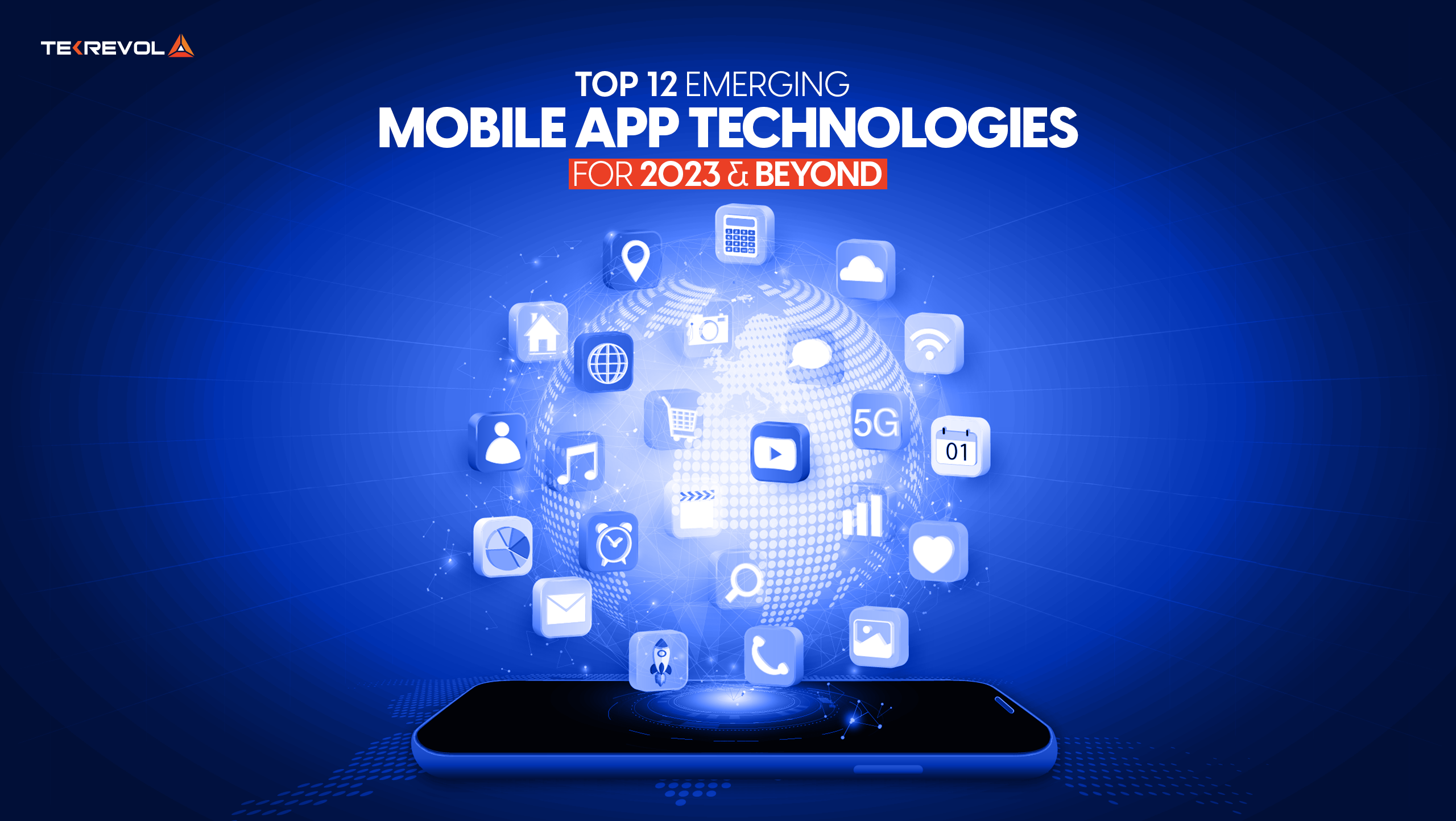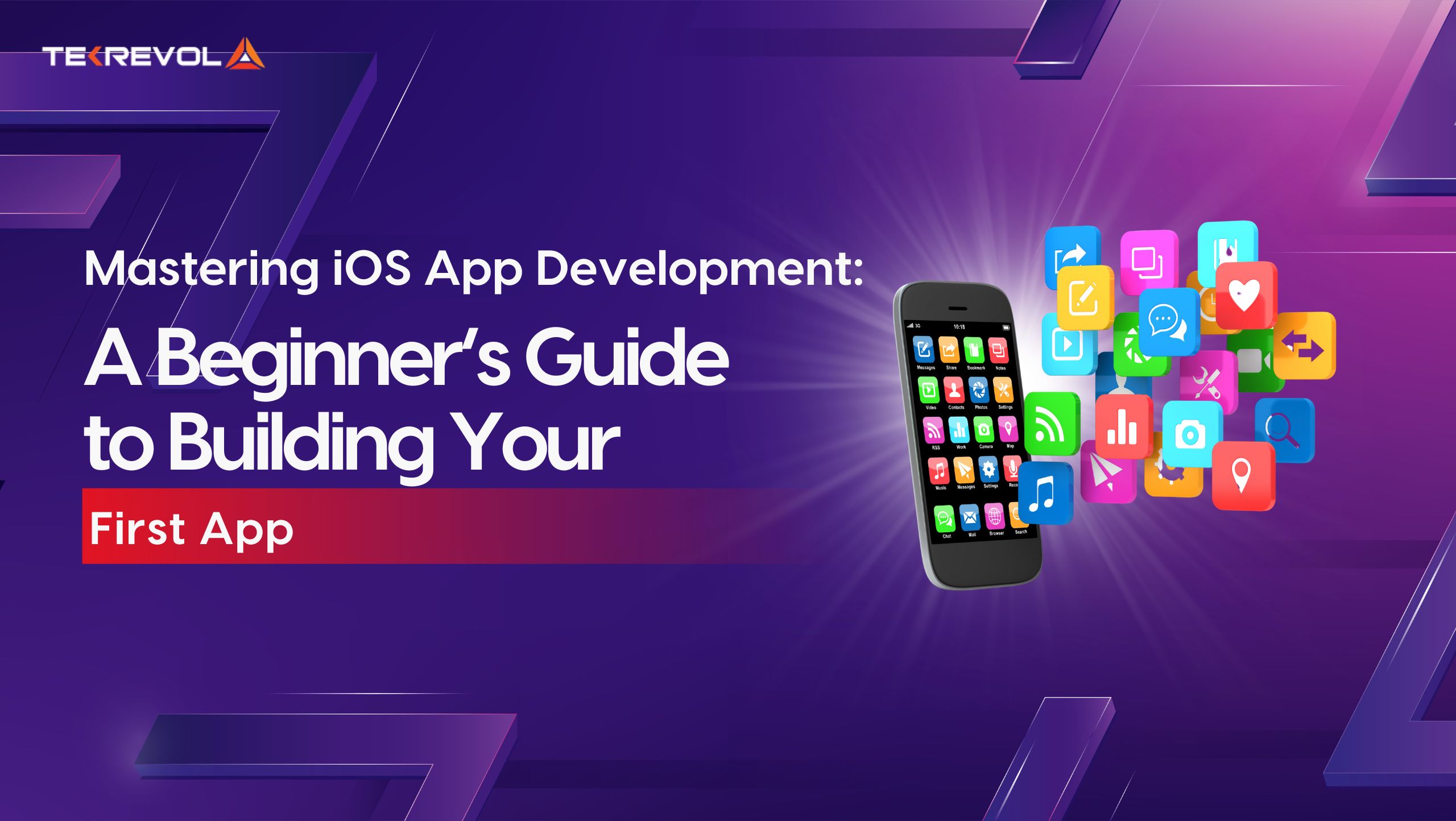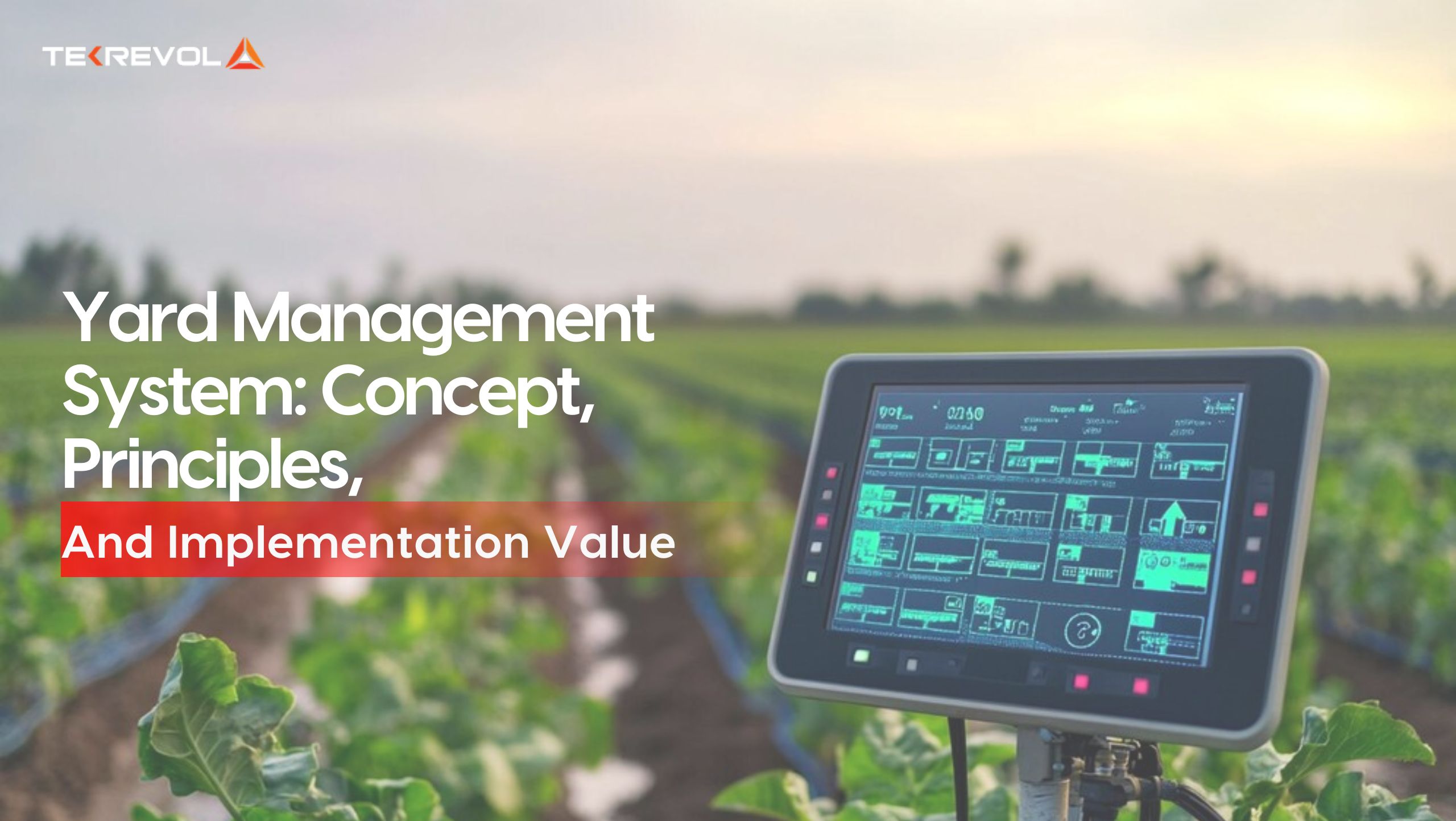In the 1940s, when programmers fed punch cards into room-sized computers, no one dreamed that we’d one day talk to our phones and let our AI assistants decide what we eat the following night.
The real challenge since then wasn’t just making computers faster-it was making them understand us. As processing power grew, so did our ambition. But there was a catch: our machines were drowning in unstructured human language.
Enter Natural Language Processing, or NLP for brevity. This would essentially bridge the gap from human speech to computer logic. Today, it happens to be the foundation in our digital interactions.
Google’s quantum chip, Willow, has already hinted at this future, promising to solve problems in minutes which would take the traditional computer millions of years. Moreover, it even hinted at parallel universes! (The Interstellar dream just got real!)
And that’s just the beginning. Now, with quantum computing entering the party, technology is all set to change everything – from how we talk to machines to how we understand our surroundings.
Curious about what’s coming next? Let’s explore the Natural language Processing Trends that will reshape our world by 2025 and beyond.
What is Natural Language Processing (NLP) and Why Does it Matter?
Before diving head-first into Natural Language Processing (NLP) and what it means for our future, let’s take a step back and understand what this field actually encompasses (for everyone to catch up).
Natural Language Processing (NLP) is one of the most fascinating subfields of artificial intelligence, where machines are trained to understand, interpret, and even generate human language.
At its core, NLP bridges the gap between human communication and machine understanding, allowing computers to read, listen, and make sense of vast amounts of text and speech.
NLP enables machines not only to “understand” what we say but also to respond intelligently, making interactions with technology feel more natural, personalized, and meaningful.
There are several key steps by which a machine processes natural language:
- Segmentation: Dividing complex sentences into smaller sentences.
- Tokenizing: Breaking sentences into individual words.
- Stop Words Removal: Filtering out common words that don’t add significant meaning (like “and,” “the,” “is”).
- Stemming: Reducing words to their base or root form.
- Lemmatization: Adding emotional context to words so machines can comprehend their emotional significance.
- Speech Tagging: Identifying grammatical terms such as nouns and verbs in sentences.
- Named Entity Tagging: Recognizing important nouns in a document, such as names of people or organizations.
The demand for NLP is skyrocketing. According to Statista, the Natural Language Processing market worldwide is projected to reach US$156.80bn in 2030.
With top AI models like OpenAI’s ChatGPT and Google’s Bard making headlines regularly, it’s clear that these advancements are not just trends—they’re the future of technology.
As these models keep improving and gaining more momentum, we can expect quite many interesting developments in NLP that will shape the way we interact with machines.
- Transform your business with NLP solutions!
- Discover how TekRevol’s natural language processing services can enhance your operations and customer engagement.
Natural Language Processing Trends to Watch in 2025 and Beyond
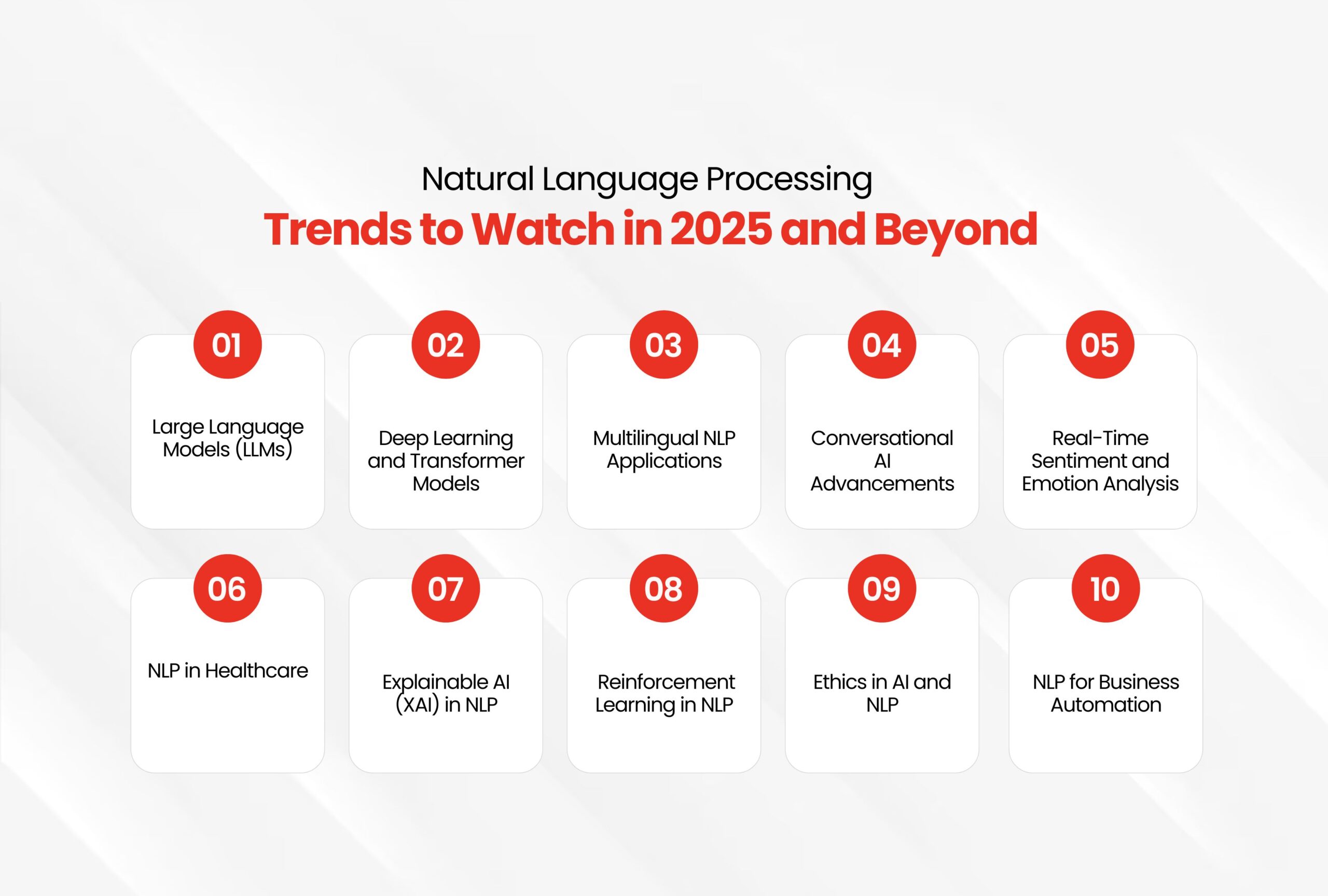
-
Large Language Models (LLMs)
The rise of Large Language Models (LLMs) marks a significant milestone in the field of Natural Language Processing. These models have transformed how machines process and produce human language, thereby making interaction with technology very intuitive.
The LLM can process very large volumes of text, learn patterns, process documents, and produce coherent responses that resemble human conversation as closely as possible.
PS: Curious how AI is reshaping education? Explore the latest innovations in AI for Education in 2025—you’ll be amazed at what’s coming.
Key Features of LLMs:
- Contextual Understanding: LLMs can understand context better than ever, which means they can provide more relevant responses.
- Multimodal Capabilities: Many modern LLMs can process text, images, and audio at the same time, which makes them much more versatile.
- Fine-Tuning for Specific Tasks: These models can be adapted for a variety of applications, from chatbots to text summarization and even content generation.
- Scalability: Recent models are designed to scale efficiently, handling larger datasets without compromising performance.
- User Interaction: For instance, because of the rapid rise in adopting LLMs, even in few days after its launch, open AI’s GPT reached over 1 million users.
Notable LLMs Making Waves in 2025:
- OpenAI’s GPT-4: Advanced version by featuring language understanding and generation.
- Anthropic’s Claude 3.5 Sonnet: Launched in June 2024 and received expertise in solving problems related to different domains.
- Meta’s Llama 3: Released in April 2024 and featured vast advancements in multilingual processing.
What to Expect in 2025
As we look ahead to 2025, some of the changes you are to expect with LLMs include the following:
- More Specialization: Models with more focus on particular industries and tasks.
- Increased Multimodal Integration: Greater ability to understand and produce content in a variety of forms.
- Ethical AI Practice: There will be an emphasis on avoiding bias and achieving fairness in AI-generated results.
- Real-time Learning: Models that dynamically learn and adjust to interactions with users.
- Broader Accessibility: Efforts to democratize access to advanced LLM technologies for businesses of all sizes.
-
Deep Learning and Transformer Models
Deep learning is now at the center stage of NLP. More importantly, it has emerged as a prominent area due to the emergence of transformer models like GPT-4, BERT, and T5.
These models have revolutionized how machines understand and generate human language, significantly enhancing tasks such as text generation, language translation, and sentiment analysis.
PS: The AI revolution is here! Explore The Future Of AI: How Artificial Intelligence Will Change The World — prepare to be amazed by tomorrow’s technology!
How Do Transformer Models Work?
The strength of such transformer models lies in processing large chunks of unstructured data in learning complex patterns within such data.
Transformers as opposed to the traditional algorithms are not necessarily handicapped by context because they can utilize attention mechanisms to hone their focus at the right parts of sentences in order to get the meaning at hand.
Such capability is essential in applications varying from chatbots to even automated content generation.
Notable Transformer Models
- OpenAI’s GPT-4: With 1.8 trillion parameters, this model excels in generating human-like text and understanding context.
- Google’s BERT: A bidirectional model that improved contextual understanding in search queries.
- T5 (Text-to-Text Transfer Transformer): Frames all NLP tasks as text generation problems, simplifying model training across tasks.
- XLNet: Addresses limitations of BERT by considering all possible permutations of words in a sentence, enhancing dependency modeling.
Industry Impact of Transformers in NLP
Advanced language models have rapidly changed the course of business in many areas. Recently, OpenAI closed a funding round that increased its valuation to $157 billion from $6.6 billion.
Amazon also doubled its investment in Anthropic to $8 billion. Such high investments indicate how AI technologies have taken precedence in today’s market.
With the introduction of advanced AI models, businesses can mechanize complex work, ease processes, and interact better with customers in more precise terms.
This phenomenon cuts across numerous sectors: creator economy and its startups like Captions, ElevenLabs, and OpusClip, which combined have brought in more than $900 million in 2024.
The increasing adoption of AI-driven solutions highlights the transformative potential of these technologies in reshaping business processes and improving efficiency.
What to Expect in 2025
As we continue looking into 2025, a number of significant changes are expected in the world of deep learning and transformer models:
- Continued model accuracy with more contextual understanding.
- Deeper specializations of the models in industry-specific usage.
- More multimodal capabilities combined with text and images or even audio to provide richer interactive means.
- Increased emphasis on ethics within AI practice aimed at minimizing biases in these models.
- Expansion of application for transformer-based models not just for text processing, but video analysis and robotics.
- Are you ready for the future of AI?
- With TekRevol’s innovative natural language processing services, you can leverage AI to enhance your business and drive growth.
-
Multilingual NLP Applications
In an increasingly globalized world, the ability to communicate across languages is more important than ever.
Multilingual NLP applications are emerging as a vital solution to overcome language barriers, enabling businesses to reach diverse audiences effectively.
These applications utilize complex algorithms to enable the processing of several languages at once, thus enabling everything from sentiment analysis to machine translation.
The Role of Multilingual Models
Transformers like mBERT (Multilingual BERT) and XLM-R (Cross-lingual RoBERTa) have been designed for text data in different languages.
These models have been trained on vast amounts of data that cover several languages, thus enabling them to learn common patterns and structures beyond linguistic boundaries.
By acquiring multilingual model-based natural language processing services, businesses can tap into this strength to expand their global reach and attract wider audiences.
Use Cases of Multilingual NLP:
| Area | Use Case |
| Automatic Translation | Real-time translation tools that help users communicate across languages. |
| Localized Customer Support | Chatbots that provide assistance in multiple languages based on user preference. |
| Sentiment Analysis Across Languages | Analyzing customer feedback from different linguistic groups for insights. |
| Content Localization | Adapting marketing materials and websites for different cultures. |
Challenges and Opportunities
While multilingual NLP models are highly effective, they still face challenges such as handling rare or underrepresented languages and ensuring cultural context is preserved.
However, as more data is collected and language-specific models are developed, the performance of multilingual NLP systems will continue to improve.
What to Expect in 2025
Moving forward, some key advances in multilingual NLP include:
- Improved Accuracy: Enhanced translation accuracy for underrepresented languages
- Cultural Context Awareness: Models will get better understand regional dialects and cultural nuances
- Broader Language Support: Increased focus on bringing low-resource languages into mainstream NLP applications
- AI-Powered Localization Tools: More advanced tools for localizing content to specific markets
- Real-Time Communication Solutions: Improvements in real-time translation technologies that make interactions smoother across languages.
-
Conversational AI Advancements
Next on our list is Conversational AI. In the recent past, Conversational AI has greatly impacted human-computer interactions in making such communications intuitive and effective.
Voice assistants like Siri, Google Assistant, and Alexa have become more mainstream. These technologies include smart chatbots, autonomous agents, or highly advanced voice assistants, where intelligent agents learn and relate to human language as humans do so.
The global conversational AI market is experiencing rapid growth, with market projections expected to reach $58.37 billion by 2031. This single statistic is enough to underscore the significance of conversational focus NLP services in the years to come.
PS: Want to future-proof your app? Read why cloud-native solutions are the future of enterprise-level applications.
Development of Intelligent Chatbots and Autonomous Agents
Intelligent chatbots and autonomous agents have become integral in various sectors, enhancing customer service, streamlining operations, and providing personalized user experiences.
A notable development in this domain is OpenAI’s Sora AI, introduced in December 2024. Sora is an AI tool that transforms text into video, enabling users to create high-quality video content through simple text prompts.
This innovation not only enhances user engagement but also democratizes video content creation, allowing individuals without technical expertise to produce professional-grade videos.
Improvements in Voice Assistants and NLP
Voice assistants have moved beyond performing simple tasks to understand the context, detecting emotions, and allowing for much more personalized conversations.
Natural Language Processing improvements have made it possible for these assistants to understand complex questions and answer them in human-like ways.
For example, with Microsoft’s introduction of its Copilot feature, it has advanced the capabilities of NLP into all applications that interact with its users in a more streamlined and intuitive way.
Human-AI Collaboration in Conversational Contexts
The human-AI collaboration in conversations has been leading to more efficient workflows and decision-making processes. AI systems now help in drafting emails, generating reports, and even participating in meetings by providing real-time insights.
This collaboration enhances productivity and allows humans to focus on more strategic tasks, leveraging AI for routine or data-intensive activities.
What to Expect in 2025
- Increased Personalization: Conversational AI systems are likely to offer more personal interactions while adapting to individual user preferences and behavior.
- Mutli-Lingual Support: There is a high push on multi-language support, with the idea that businesses could better serve their global market.
- Emerging Technologies: Conversational AI is increasingly likely to connect with AR and VR-based technologies for the sake of delivering an enhanced user experience.
- Focus on Ethical AI: The more conversational AI becomes, the more the world will focus on ethical considerations: data privacy, consent, and mitigating biases in AI responses.
- Discover the benefits of NLP for your business!
- At TekRevol, we offer tailored natural language processing services that meet your unique needs and challenges.
-
Real-Time Sentiment and Emotion Analysis
Imagine a world where your favorite brand knows exactly how you feel about their latest product launch before you even post a review. For those who think AI lacks emotions, you’re in for a surprise!
The future of Real-Time Sentiment and Emotion Analysis is set to change how businesses interact with their customers by understanding not just what people are saying but how they truly feel.
The application of sentiment analysis in NLP is rapidly evolving as companies recognize the importance of gauging customer emotions. Advanced models now track not only basic sentiments (positive, negative, neutral) but also more detailed emotional tones such as joy, anger, frustration, and excitement.
This depth allows businesses to acquire natural language processing services to refine marketing strategies and enhance customer service approaches effectively.
Advanced Sentiment Analysis Capabilities
Today’s sentiment analysis tools leverage machine learning algorithms that can detect subtle nuances in language.
Companies are using these tools to monitor customer feedback across various platforms—social media mentions, product reviews, and surveys—to assess public sentiment toward their brands.
This capability empowers organizations to empower their product development by making data-driven decisions that align closely with customer feelings.
Integration with Business Intelligence
As sentiment analysis becomes more sophisticated, its integration with business intelligence (BI) systems is also on the rise.
By combining sentiment data with other business metrics like sales figures or customer support interactions, companies can gain comprehensive insights into customer satisfaction and preferences.
What to Expect in 2025
Looking forward to 2025, we can anticipate several key advancements in real-time sentiment analysis:
- Improved accuracy in detecting complex emotions such as sarcasm or irony.
- Enhanced integration with BI tools for deeper insights into customer behavior.
- Real-time monitoring capabilities that allow brands to respond proactively to emerging trends or issues.
- Greater focus on privacy and ethical considerations surrounding customer data usage.
- Development of tools that provide actionable insights directly linked to marketing strategies.
-
NLP in Healthcare
The healthcare industry is one of the primary sectors benefiting from advancements in Natural Language Processing (NLP).
With an ever-growing volume of unstructured data—ranging from clinical notes to medical research papers—NLP is proving essential in organizing, interpreting, and leveraging this information to improve patient care and clinical outcomes.
Transforming Medical Data Management
NLP algorithms are dramatically reshaping how healthcare professionals extract insights from clinical records.
By processing vast amounts of unstructured data, these tools enable more accurate diagnoses, treatment recommendations, and predictive analytics.
For instance, NLP can identify patterns in patient histories, flag potential health risks, and assist in clinical decision-making.
Improving Patient Experience and Data Privacy
NLP in healthcare isn’t just about enhancing clinical efficiency; it’s also about improving the patient experience.
Virtual assistants powered by NLP help patients schedule appointments, ask questions, and receive tailored health advice.
However, data privacy remains a significant concern, and developers are focusing on ensuring that these systems comply with healthcare regulations like:
- HIPAA (Health Insurance Portability and Accountability Act)
- and GDPR (General Data Protection Regulation)
- FERPA (Family Educational Rights and Privacy Act)
- Data Protection Act 2018
Natural Language Processing (NLP) In Healthcare And Life Sciences Market is expected to generate a revenue of USD 9.57 Billion by 2031. (Source: Finance.Yahoo)
What to Expect in 2025
As we look ahead to 2025, here are some key developments we can anticipate in NLP within healthcare:
- Advanced Clinical Decision Support Systems (CDSS): These systems will provide even more sophisticated real-time insights by analyzing extensive datasets, including medical literature and clinical trials.
- Voice-Activated Tools: Expect improvements in voice-activated NLP tools that allow healthcare providers to dictate notes and update records hands-free.
- Enhanced Patient Engagement: Virtual assistants will become more capable of providing personalized health advice based on individual patient data.
- Stronger Data Privacy Measures: Innovations will focus on ensuring compliance with regulations while maintaining the integrity of patient data.
- Integration with Wearable Technology: NLP will play a crucial role in interpreting data from wearable devices to provide real-time health monitoring.
- Ready to transform your healthcare business with NLP?
- At TekRevol, we have extensive experience in natural language processing services to enhance patient care and streamline operations.
-
Explainable AI (XAI) in NLP
As Natural Language Processing (NLP) systems become increasingly sophisticated, the demand for Explainable AI (XAI) has surged.
The complexity of these models raises concerns about transparency and accountability, especially in industries like finance and healthcare, where decisions can significantly impact lives. XAI aims to demystify how these models operate, ensuring that users can understand and trust their outputs.
One major driver for XAI in NLP is regulatory compliance. For instance, financial institutions must provide clear justifications for automated decisions, such as loan approvals.
Understanding model behavior not only helps reduce errors but also allows organizations to anticipate strengths and weaknesses, ultimately avoiding unexpected outcomes in production.
Moreover, XAI plays a crucial role in identifying and mitigating biases present in training data, fostering inclusivity in AI applications.
How XAI Works in NLP
- Visualizing Attention Mechanisms: By illustrating which parts of the input text the model focuses on during processing, users gain insights into its decision-making.
- Generating Textual Explanations: Models can produce explanations for their predictions in natural language, making it easier for users to comprehend.
- Interpreting Reasoning Processes: Techniques that elucidate the logic behind model decisions help users understand how conclusions are reached.
What’s the Difference Between AI and XAI?
The difference between traditional AI and Explainable AI lies in transparency. While standard AI models often operate as “black boxes,” providing results without clear reasoning, XAI incorporates methods that ensure each decision made during the machine learning process can be traced and explained. This capability enhances accountability and trust among users.
What Areas Will XAI Transform?
Explainable AI is making significant strides across various sectors:
- Healthcare: Enhancing trust in AI-driven diagnostics by providing clarity on how decisions are made.
- Finance: Supporting compliance with regulations by explaining the rationale behind credit decisions.
- Customer Service: Improving user experience with chatbots that articulate their reasoning when responding to inquiries.
- Marketing: Allowing businesses to understand consumer sentiment through transparent analysis of feedback.
- Legal: Aiding legal professionals by clarifying how AI tools reach conclusions in case assessments.
What to Expect in 2025
Looking ahead to 2025, several advancements are anticipated in Explainable AI:
- The focus will shift towards creating user-specific explanations tailored to different levels of technical expertise.
- More models will be designed with explainability built-in from the ground up, enhancing their interpretability.
- Counterfactual explanations will emerge, allowing users to see how changes in input affect model outputs.
- The toolbox for XAI will expand with new methodologies applicable across various AI models.
- Regulatory frameworks mandating explainability will likely become more prevalent, driving further innovation in this area.
-
Reinforcement Learning in NLP
What’s your biggest nightmare when it comes to AI? For many, it’s the thought of machines evolving beyond our control, learning things they shouldn’t, and ultimately taking over the world. Our next Natural Language Processing Trend is Reinforcement Learning (RL).
As the ancient adage goes, “Experience is the best teacher.” This philosophy underpins RL, where machines learn optimal behaviors through feedback from their environment. For those who believe that AI lacks the ability to grow and adapt, reinforcement learning is here to change that perception.
This trend is revolutionizing how machines learn from their environment, adapting and improving just like a child does.
Current Developments and Industry Impact
The landscape of reinforcement learning is rapidly evolving, with numerous startups and established companies investing heavily in this technology.
For instance, DeepMind, known for its groundbreaking work in AI, has been exploring RL applications across various domains.
Similarly, OpenAI has incorporated reinforcement learning techniques in its models to enhance their adaptability and performance.
According to recent reports, the global reinforcement learning market size reach USD 88.7 billion by 2032, highlighting the increasing demand for this technology.
What Areas Will Reinforcement Learning Transform?
Reinforcement learning’s ability to learn through interaction opens up diverse applications across various domains:
- Game Playing: RL algorithms have enabled machines to master complex games like Go and Chess, showcasing strategic thinking that often surpasses human capabilities.
- Robotics: Robots can learn tasks such as object manipulation and navigation in unpredictable environments, enhancing their operational efficiency.
- Finance: RL plays a crucial role in portfolio management and algorithmic trading by analyzing market conditions and optimizing investment strategies.
- Healthcare: Applications include treatment optimization and personalized patient care by analyzing individual patient data for better outcomes.
- Autonomous Vehicles: RL is essential for developing self-driving cars that adapt to real-world driving conditions through experiential learning.
What to Expect in 2025
As reinforcement learning continues to advance, several key trends are expected to shape its future:
- Improvements in deep reinforcement learning will lead to more autonomous systems capable of handling complex tasks independently.
- The integration of transfer learning will allow agents to apply previously learned skills to new problems more efficiently.
- Multi-agent reinforcement learning will facilitate collaboration among multiple agents, enhancing problem-solving capabilities in real-world scenarios.
- Robustness and generalization will improve, making RL systems more adaptable to changing environments.
- Increased regulatory focus will drive the development of ethical frameworks for implementing reinforcement learning responsibly.
- Transform data into decisions with NLP!
- Discover how TekRevol’s natural language processing services can help you analyze and act on crucial information quickly.
-
Ethics in AI and NLP
How often do you find your social media feed suggesting posts that barely interest you, or your email inbox mistakenly pushing important messages into the spam folder? These frustrating experiences are often the result of biases in AI algorithms.
As technology becomes more integrated into our daily lives, the ethical implications of how these systems function are coming under increased scrutiny. With the rise of Natural Language Processing (NLP), there is a pressing need to address bias in AI models, ensuring they operate fairly and transparently.
The growing concern over bias in NLP stems from the fact that these models are trained on extensive datasets that may contain societal prejudices related to race, gender, or socio-economic status.
As we approach 2025, addressing these biases is becoming a significant trend. Developers are increasingly focused on creating ethical NLP systems that not only improve accuracy but also ensure fairness and inclusivity in their outputs.
Types of Ethical Biases in AI and NLP
- Gender Bias: NLP models may associate certain professions with specific genders, reinforcing stereotypes (e.g., “nurse” as female and “doctor” as male).
- Racial Bias: Language models can produce racially biased language or fail to recognize diverse cultural contexts.
- Cultural Bias: Algorithms might misrepresent or overlook certain cultural practices, leading to misunderstandings.
- Economic Bias: AI systems may favor candidates from affluent backgrounds during hiring processes, perpetuating inequality.
Mitigating Bias in NLP Models
Organizations are investing heavily in tools and techniques designed to identify and reduce biases within NLP systems.
Techniques such as adversarial training test models against scenarios that expose bias, while data balancing ensures that training datasets are diverse and representative.
Recent developments include new regulations aimed at promoting fairness in AI applications, compelling companies to adopt best practices for ethical AI development.
What to Expect in 2025
As we move forward, developing fair and inclusive AI will be a key priority. Companies will increasingly focus on creating NLP systems that serve all users equitably.
- Expect advancements in tools that help identify bias during model training.
- Regulatory frameworks will likely become more stringent, requiring companies to demonstrate fairness.
- The integration of ethical considerations into the design phase of AI development will become standard practice.
- Increased collaboration between tech companies and advocacy groups to address bias issues.
- A greater emphasis on community engagement to ensure diverse perspectives are included in model training.
-
NLP for Business Automation
As we approach the end of 2024, the integration of Natural Language Processing (NLP) in business automation is rapidly gaining momentum.
Companies are leveraging NLP to reshape how they process and analyze information, make decisions, and gain competitive advantages.
From sentiment analysis of customer feedback to automated report generation and real-time market trend analysis, NLP empowers businesses to extract actionable insights from unstructured data that was previously challenging to leverage.
Additionally, advancements like zero-shot learning in NLP are enhancing the ability of models to perform tasks without extensive retraining, further streamlining operations.
NLP for Business Intelligence
One of the most promising applications of NLP technology is in business intelligence (BI). Companies are using NLP to analyze vast amounts of data, enabling them to make informed decisions quickly.
For instance, Netflix employs sophisticated NLP algorithms to analyze viewer behavior and preferences, allowing it to deliver personalized content recommendations that enhance user engagement.
Use Cases of NLP in Business Intelligence
NLP is making a significant impact on business intelligence across various applications:
- Customer Service Automation
AI-powered chatbots streamline customer interactions by providing instant responses and personalized solutions. For example, Bank of America’s Erica assists users with banking tasks, handling over 100 million requests since its launch.
- Market Intelligence and Social Media Monitoring
Companies like American Express use NLP to monitor customer sentiments across social media platforms, allowing them to proactively address concerns and refine strategies.
- Data-Driven Human Resources
Organizations utilize NLP tools for automating candidate screening and analyzing employee feedback. This approach helps companies like KPMG enhance their HR processes by identifying top talent quickly.
- Legal and Compliance Monitoring
Firms leverage NLP for contract analysis and regulatory compliance checks. For instance, ROSS Intelligence simplifies legal research by understanding context and meaning in case law.
- Financial Analysis
Cutting-edge systems process financial reports and market data to generate insights. Companies like John Snow Labs apply NLP in healthcare finance to assess treatment outcomes based on patient data.
Industries That Will Be Transformed
The impact of NLP extends across numerous industries, driving significant changes:
- Finance and Banking: With applications in fraud detection and automated trading, NLP is revolutionizing how financial institutions operate.
- Healthcare: By analyzing medical records and clinical notes, NLP enhances patient care and operational efficiency.
- E-commerce: Personalized shopping experiences are being created through advanced recommendation systems powered by NLP.
- Marketing: Brands are using sentiment analysis to gauge public opinion and tailor their marketing strategies accordingly.
What to Expect in 2025
Looking ahead, developing fair and inclusive AI will be a key priority in 2025, with an emphasis on creating NLP systems that serve all users equitably.
The need for transparency in AI models is also gaining momentum, with companies aiming to make the decision-making processes of their NLP models more understandable and accountable.
- Ready to automate your business processes?
- At TekRevol, we specialize in natural language processing services that streamline operations and enhance efficiency.
How TekRevol Can Help You Stay Ahead of the Curve with NLP
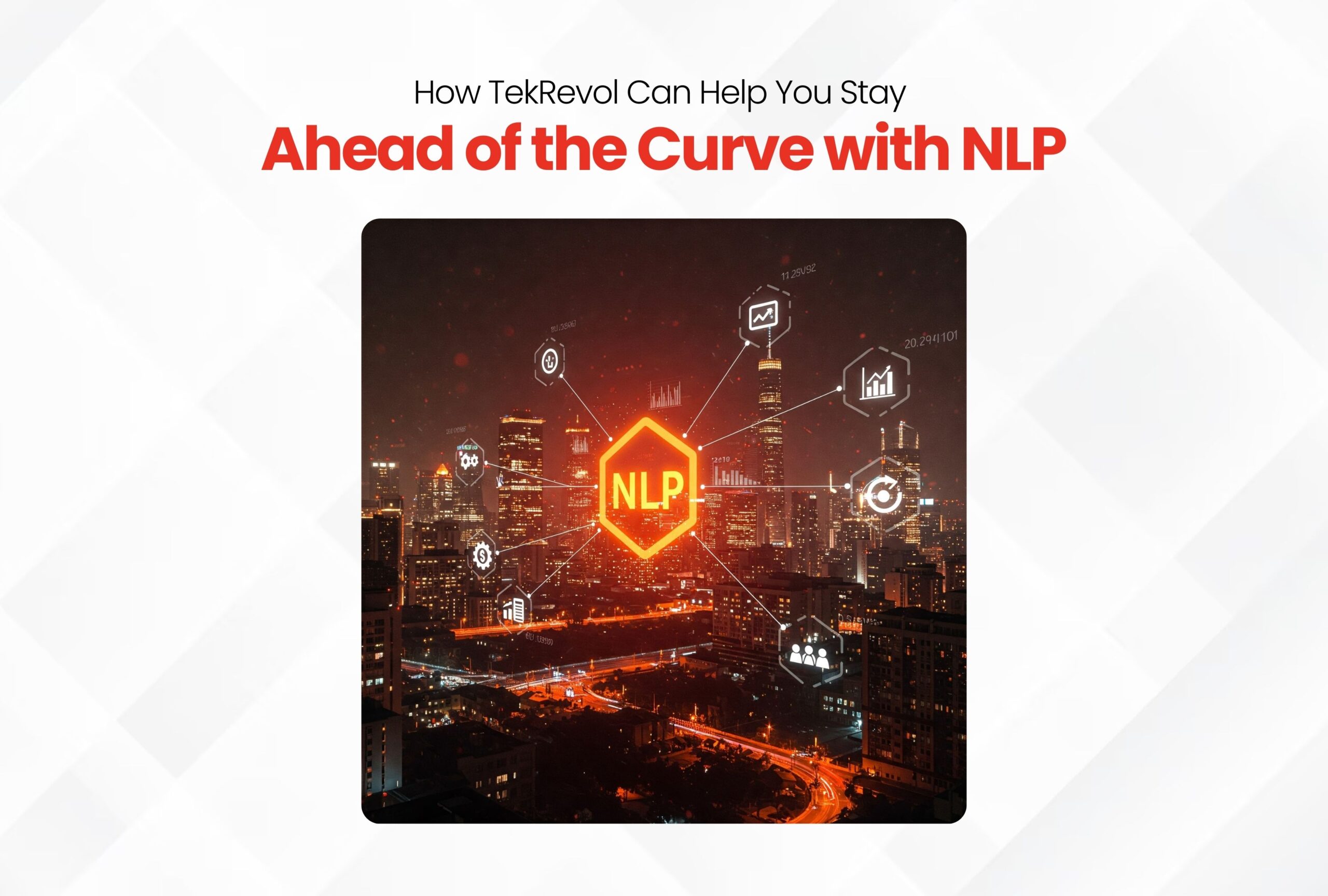
As you’ve explored throughout this article, the future of Natural Language Processing (NLP) is bright, and investing in these technologies is crucial for staying competitive.
Businesses that fail to adopt NLP risk falling behind as their competitors leverage advanced capabilities to enhance operations and improve customer experiences. TekRevol is here to ensure you don’t get left behind.
With our extensive experience in NLP development, we offer a suite of services designed to transform your business operations. Our team has successfully implemented NLP solutions for various industries, leading to improved efficiency and significant cost reductions.
With 5+ years of proven experience in the field, TekRevol has been recognized as one of the top companies in the field, with a proven track record of delivering high-performance NLP solutions tailored to your specific needs.
Ready to Transform Your Business?
Don’t wait for the future—embrace it! Contact TekRevol today to learn how our natural language processing services can revolutionize your operations and help you stay ahead of the curve.
- Don’t let data go to waste—use NLP!
- At TekRevol, our natural language processing services turn data into actionable strategies for better outcomes.

 6190 Views
6190 Views February 24, 2025
February 24, 2025